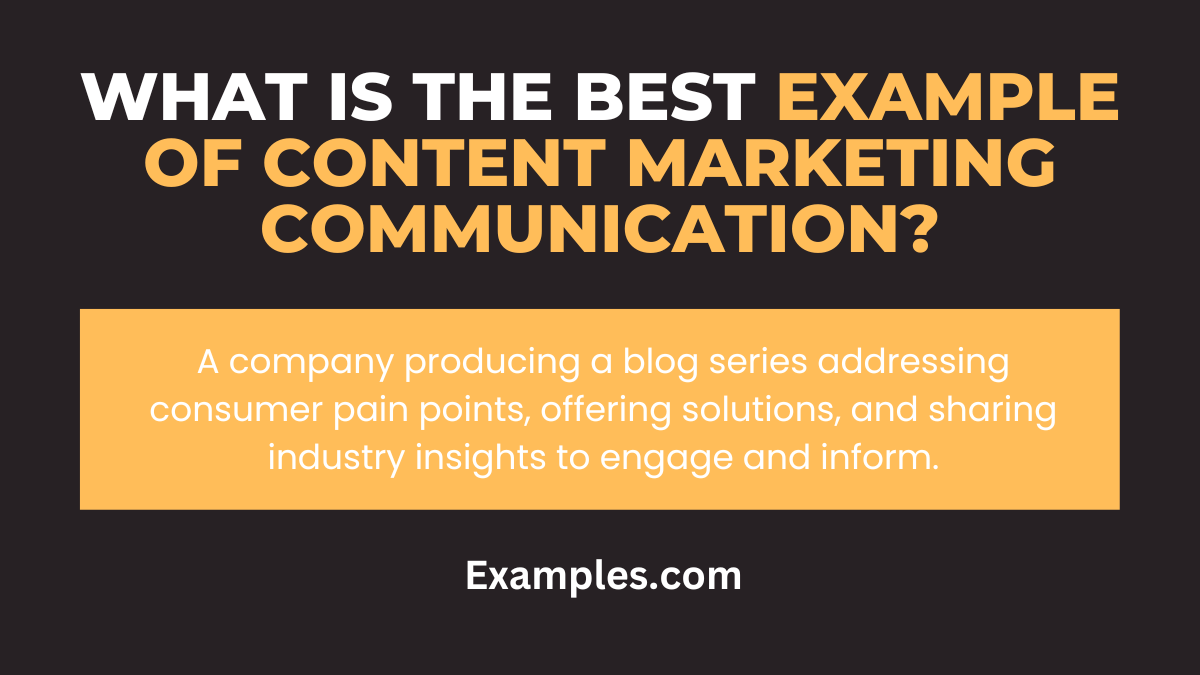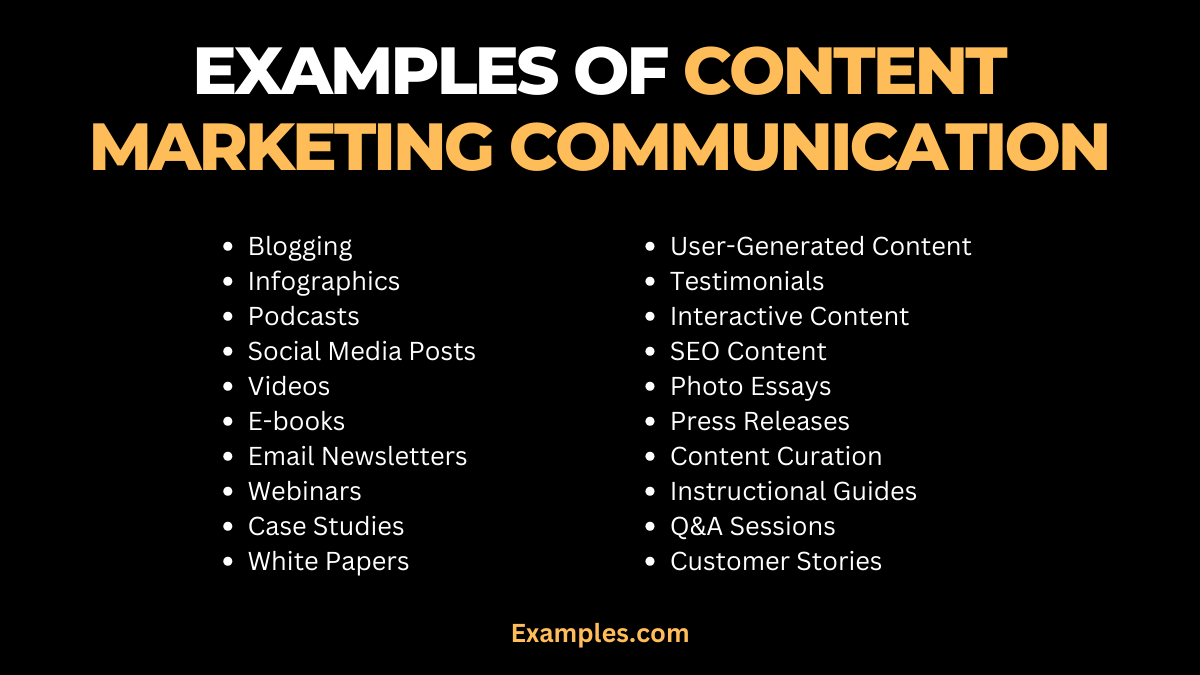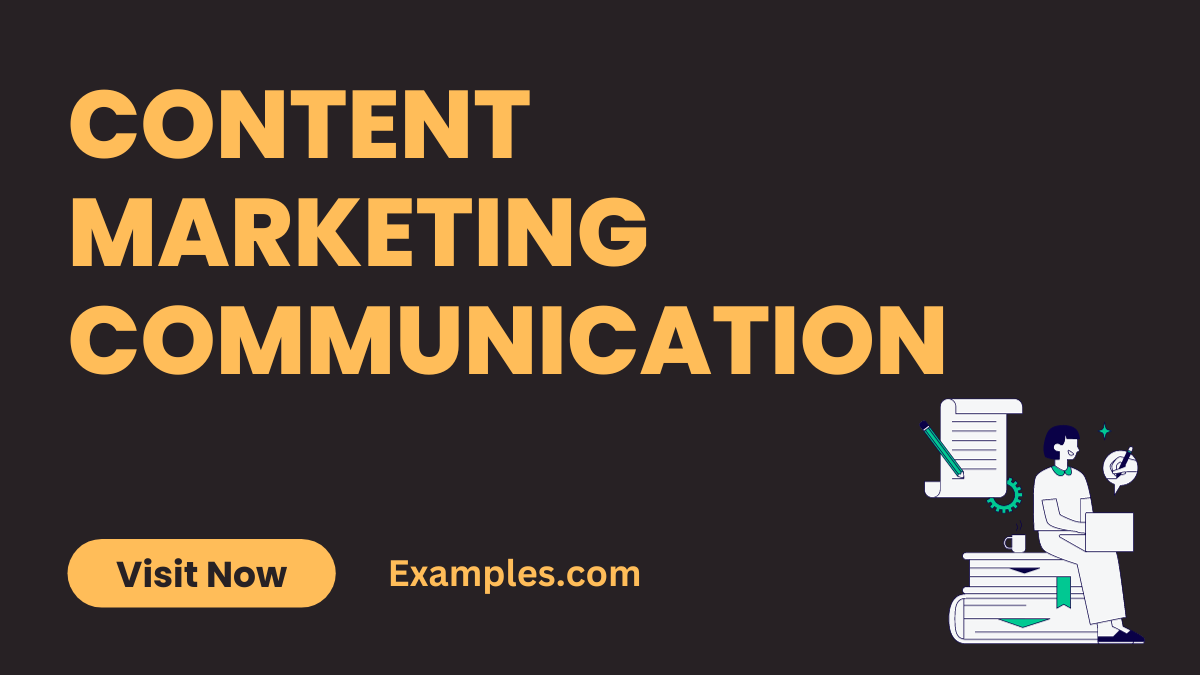19+ Content Marketing Communication Examples
In today’s digital landscape, Content Marketing Communication stands as a pivotal component in shaping brand narratives. This guide dives deep into the realm of effective communication, highlighting various Marketing Communication Examples and techniques. From crafting compelling messages to leveraging strategic tools, we cover all dimensions of content marketing. This resource is ideal for marketers and businesses aiming to amplify their voice in a crowded marketplace. Discover how to seamlessly integrate creativity with strategy, elevating your brand’s communication to new heights.
Download List of Content Marketing Communication
What is Content Marketing Communication?

Content Marketing Communication refers to the strategic process of creating and distributing valuable, relevant, and consistent content to attract and engage a specific audience. This approach aims to establish and nurture relationships with potential and existing customers, ultimately driving profitable customer action. It’s a blend of art and science, requiring creativity, strategic planning, and understanding of the Marketing Communication Process.
What is the Best Example of Content Marketing Communication?

A quintessential example of Content Marketing Communication is the use of storytelling in brand campaigns. For instance, a company sharing customer success stories through various Marketing Communication Channels like blogs, videos, and social media. This approach not only showcases the product’s impact but also resonates emotionally with the audience, building trust and loyalty. It’s an effective demonstration of how content can be leveraged to convey a brand’s values and connect with its audience on a deeper level, aligning with the Purpose of Marketing Communication.
Examples of Content Marketing Communication

Content Marketing Communication plays a pivotal role in modern business strategies, focusing on creating and distributing valuable, relevant, and consistent content. It aims to attract and engage a specific audience, ultimately driving profitable customer action. This approach is crucial for building brand awareness, fostering relationships, and enhancing online visibility.
- Blogging: A cornerstone of Content Marketing Communication, blogging offers in-depth information about products or services, often solving common customer problems.
- Infographics: These combine visuals and text to explain complex topics, making them a popular tool in marketing strategies.
- Podcasts: A growing trend, podcasts in marketing communication provide a personal touch, allowing brands to connect with their audience on a more intimate level.
- Social Media Posts: Leveraging platforms like Facebook or Instagram, these posts can increase engagement and brand visibility.
- Videos: From tutorials to behind-the-scenes glimpses, videos are an engaging way to showcase products or services.
- E-books: They are an effective way to provide comprehensive knowledge on specific topics, establishing a brand as a thought leader.
- Email Newsletters: Regular newsletters keep subscribers informed and engaged with the latest company news and offers.
- Webinars: These interactive online seminars are a powerful tool for educating and engaging with a targeted audience.
- Case Studies: Sharing success stories of how your product or service helped a client can build trust and credibility.
- White Papers: Often used in B2B marketing, white papers are detailed reports on specific topics that help in decision-making processes.
- User-Generated Content: Encouraging customers to share their experiences enhances authenticity and trust.
- Testimonials: Highlighting customer feedback on websites or social media strengthens reputation and reliability.
- Interactive Content: Quizzes or polls on social media or websites increase user engagement.
- SEO Content: Optimizing web content for search engines increases visibility and attracts more website traffic.
- Photo Essays: A series of photographs telling a story can be a powerful way to communicate a brand’s message.
- Press Releases: Useful for announcing new products, services, or events, helping in gaining media coverage.
- Content Curation: Sharing relevant third-party content can establish a brand as a knowledgeable industry leader.
- Instructional Guides: These provide step-by-step instructions and add value for the audience.
- Q&A Sessions: Hosting live Q&A sessions on social media or webinars can directly engage with the audience.
- Customer Stories: Sharing real-life experiences of customers using the product or service adds a human element to the brand.
Importance of Content Marketing Communication
Content Marketing Communication plays a pivotal role in modern marketing strategies. Here are eight key points highlighting its importance:
- Building Brand Awareness: Through consistent and relevant content, companies can significantly boost their brand visibility and recognition.
- Establishing Thought Leadership: Quality content establishes a brand as a thought leader in its industry, fostering trust and credibility.
- Enhancing Customer Engagement: Engaging content encourages interaction, leading to stronger customer relationships.
- Supporting SEO Efforts: Content marketing boosts search engine optimization, increasing online visibility and organic traffic.
- Facilitating Customer Education: Content educates potential customers about products or services, aiding in the decision-making process.
- Driving Conversions: Effective content can lead directly to increased sales and conversions.
- Supporting Other Marketing Tactics: Content marketing complements and enhances other forms of marketing communication strategies and marketing communication channels.
- Long-Term Value: Quality content offers lasting value, continuing to attract and engage audiences over time.
Types of Content Marketing Communication
Content Marketing Communication encompasses various types, each serving distinct purposes in a marketing strategy. Here are eight types:
- Blog Posts: Offer valuable information, tips, and insights related to your industry.
- Videos: Engaging and visually appealing, ideal for demonstrations or storytelling.
- Infographics: Visually represent data or information, making complex topics easily digestible.
- Case Studies: Showcase real-life examples of how your product or service has helped customers.
- Ebooks and Whitepapers: Provide in-depth knowledge or expertise on specific topics.
- Email Newsletters: Keep your audience updated and engaged with regular communication.
- Social Media Posts: Enhance brand presence and engage directly with your audience.
- Podcasts: Offer auditory content for audiences preferring listening over reading.
Benefits of Content Marketing Communication
The benefits of Content Marketing Communication are numerous and impactful. Here are eight key benefits:
- Increased Traffic: Regular, quality content drives more traffic to your website.
- Improved Brand Reputation: Sharing valuable content helps build a positive brand image.
- Higher Engagement Rates: Good content encourages more audience interaction.
- Better Customer Retention: Quality content adds value, keeping customers coming back.
- Cost-Effectiveness: Compared to traditional marketing, content marketing is often more budget-friendly.
- Enhanced SEO: Quality content improves search engine rankings, increasing visibility.
- Greater Reach: Content can be shared widely, extending your brand’s reach.
- Data Collection: Content engagement provides valuable data on customer preferences and behaviors.
How to Get Started with Content Marketing
- Understand Your Audience: Begin by identifying and understanding your target audience. This involves researching their needs, preferences, and behavior. Use this information to tailor your content to meet their specific interests.
- Define Your Goals: Clearly define what you want to achieve with your content marketing. This could include increasing brand awareness, generating leads, or driving sales. Align these goals with your overall Marketing Communication Objectives.
- Develop a Content Strategy: Create a comprehensive plan that outlines the type of content you will produce. This should align with your Marketing Communication Strategies, ensuring that each piece of content contributes to your overall marketing goals.
- Choose the Right Channels: Decide on the most effective Marketing Communication Channels to distribute your content. This could be through social media, blogs, email newsletters, or other platforms where your audience is most active.
- Create High-Quality Content: Develop engaging, informative, and valuable content. This could range from blog posts and videos to infographics and podcasts, depending on what resonates best with your audience.
- Optimize for SEO: Ensure your content is optimized for search engines to increase visibility. Use relevant keywords, meta descriptions, and tags to improve search rankings.
- Promote Your Content: Actively promote your content across various platforms. This could include social media advertising, email marketing, and collaborating with influencers or other brands.
- Measure and Analyze: Regularly track and analyze the performance of your content. Use these insights to refine your strategy, improve content quality, and better align with your audience’s needs.
Content Marketing Communication Tools
- Content Management Systems (CMS): Use CMS tools like WordPress or Drupal to create, manage, and publish your content efficiently. These systems offer a variety of features to streamline the content creation process.
- SEO Tools: Utilize SEO tools like SEMrush or Google Analytics to optimize your content for search engines. These tools provide insights into keyword performance, website traffic, and audience behavior.
- Social Media Management Tools: Leverage tools like Hootsuite or Buffer to schedule and manage your content across different social media platforms. This helps maintain a consistent online presence and engage with your audience effectively.
- Email Marketing Software: Implement email marketing tools like Mailchimp or Constant Contact to distribute your content directly to your audience’s inbox. These tools offer features for personalized campaigns and analytics.
- Content Collaboration Tools: Use collaboration tools like Google Docs or Asana for team collaboration. These tools help in streamlining the content creation process, especially when working with a team.
- Graphic Design Software: Employ design tools like Adobe Photoshop or Canva to create visually appealing content. High-quality visuals are crucial for engaging your audience and enhancing your brand image.
- Analytics and Reporting Tools: Incorporate analytics tools to track the performance of your content. This data is vital for understanding the impact of your content and making informed decisions.
- Content Curation and Aggregation Tools: Use tools like Feedly or Curata to find and share relevant content with your audience. This helps in keeping your content fresh and diverse while saving time on content creation.
By incorporating these strategies and tools, you can effectively initiate and enhance your Content Marketing Communication, ensuring it aligns with your overall marketing goals and resonates with your target audience.
What are the key elements of content marketing?
Content marketing centers on creating valuable content, utilizing Marketing Communication Strategies, and engaging audiences. Key elements include consistency, relevance, and integration with Marketing Communication Channels.
What is the content dimension of communication?
The content dimension of communication in marketing involves message substance and information depth. It’s critical in Content Marketing Communication, blending creativity with Marketing Communication Objectives to engage audiences effectively.
What are the 5 C’s of content marketing?
The 5 C’s of content marketing are: Creativity, Consistency, Customization, Collaboration, and Cross-channel distribution. These elements ensure effective Content Marketing Communication, aligning with Marketing Communication Plans for optimal impact.
Effective Marketing Communication Strategies and Integrated Marketing Communication Techniques are pivotal in shaping a brand’s engagement and success. Utilizing diverse channels, from Email Marketing Communication to Social Media Marketing Communication, these strategies ensure that messages resonate with target audiences. Understanding the Importance of Marketing Communication, businesses can craft compelling narratives, fostering meaningful connections with consumers and driving business growth. Ultimately, mastering these communication methods is a game-changer in today’s dynamic marketing landscape.



